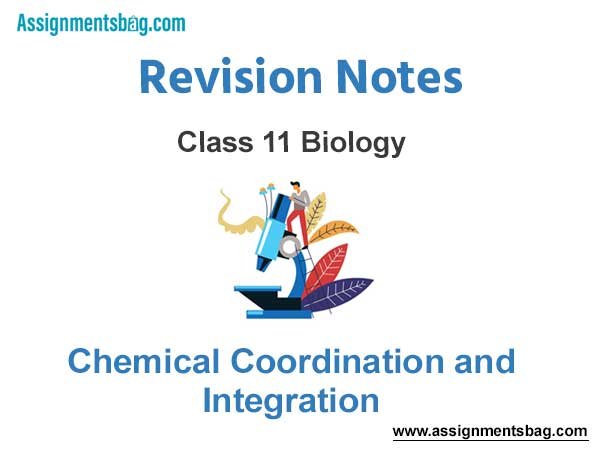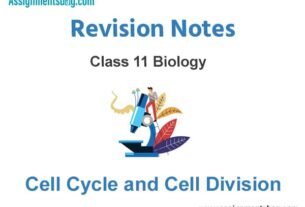Please see Chemical Coordination and Integration Class 11 Biology Revision Notes provided below. These revision notes have been prepared as per the latest syllabus and books for Class 11 Biology issues by CBSE, NCERT, and KVS. Students should revise these notes for Chapter 22 Chemical Coordination and Integration daily and also prior to examinations for understanding all topics and to get better marks in exams. We have provided Class 11 Biology Notes for all chapters on our website.
Chapter 22 Chemical Coordination and Integration Class 11 Biology Revision Notes
Endocrine system includes endocrine (ductless) glands and their secretions (hormones).
Hormones are non-nutrient chemicals that act as intercellular messengers and are produced in trace amounts.
HUMAN ENDOCRINE GLANDS
They include
1. Hypothalamus
2. Pituitary
3. Pineal
4. Thyroid
5. Parathyroid
6. Thymus
7. Adrenals
8. Pancreas (Islets of Langerhans)
9. Gonads (Testis & Ovary)

1. HYPOTHALAMUS
Neurosecretory cells (nuclei) of hypothalamus secrete the following types of hormones:

♦ Releasing hormones: Stimulate secretion of pituitary hormones. E.g. gonadotropin releasing hormone (GnRH) stimulates pituitary to release gonadotropins (FSH & LH).
♦ Inhibiting hormones: Inhibit secretion of pituitary hormones. E.g. Somatostatin inhibits release of growth hormone from pituitary.
♦ Oxytocin & vasopressin: These are transported axonally and stored in pituitary. (See pituitary gland).
2. PITUITARY GLAND
♦ It is located in a bony cavity called sella tursica.
♦ It is attached to hypothalamus by a stalk.
♦ It is divided into anterior Adenohypophysis & posterior Neurohypophysis.
a. Adenohypophysis
It has 2 parts: Pars distalis and Pars intermedia. Pars distalis (Anterior pituitary): It produces
1. Somatotropin (Growth hormone, GH): For body growth. Its over-secretion causes Gigantism (abnormal growth). Hyposecretion causes Dwarfism (stunted growth). Over-secretion of GH in adults (mainly in middle age) causes Acromegaly (severe disfigurement especially of face). It leads to serious complications and premature death. Early diagnosis of the disease is difficult. It may be undetected for many years.
2. Prolactin (PRL): Regulates growth of mammary glands and milk production.
3. Thyroid stimulating hormone (TSH): Stimulates thyroid gland to secrete thyroid hormones.
4. Adrenocorticotrophic hormone (ACTH): Stimulates adrenal cortex to synthesise & secrete steroid hormones (glucocorticoids).
5. Follicle stimulating hormone (FSH): Stimulates gonadal activity. In males, FSH & androgens regulate sperm formation (spermatogenesis). In females, FSH stimulates growth and development of ovarian follicles.
6. Luteinizing hormone (LH): Stimulates gonadal activity. In males, it stimulates synthesis and secretion of androgens from testis. In females, it induces ovulation and maintains the corpus luteum.
Pars intermedia: In human, it is almost merged with pars distalis. It produces Melanocyte stimulating hormone (MSH). It acts on melanocytes to regulate skin pigmentation.
b. Neurohypophysis
It stores Oxytocin & Vasopressin from hypothalamus.
♦ Oxytocin: Contracts smooth muscles. In females, it stimulates contraction of uterus during child birth, and milk ejection from the mammary gland.
♦ Vasopressin or Anti-diuretic hormone (ADH): Stimulates reabsorption of water & electrolytes by DCT of kidney and thereby reduces diuresis (loss of water through urine). Deficiency of ADH results in diminished ability of the kidney to conserve water. It leads to water loss and dehydration. This is called Diabetes insipidus.
3. PINEAL GLAND
Smallest endocrine gland: It is located on dorsal side of forebrain. Secretes melatonin.
Functions of melatonin:
1. Regulates diurnal (24-hour) rhythm of body. E.g. sleep-wake cycle, body temperature etc.
2. Influences metabolism, pigmentation & menstrual cycle.
3.Influences defense capability.
4. THYROID GLAND

♦ Largest endocrine gland.
♦ It includes 2 lobes on either side of the trachea. The lobes are interconnected with isthmus (a connective tissue).
♦ Thyroid gland is made of follicles & stromal tissues.
Follicular cells secrete the following hormones:
Thyroxin (tetraiodothyronine, T4) & Triiodothyronine (T3): Their functions are
1. Regulation of basal metabolic rate (BMR).
2. Physical, mental and sexual development.
3. Support RBC formation.
4. Control metabolism of carbohydrates, proteins & fats.
5. Maintain water and electrolyte balance.
Thyrocalcitonin (TCT): A protein hormone. It regulates (lowers) blood calcium levels (Hypocalcaemic hormone).
Iodine is essential for normal hormone synthesis in thyroid.
Hypothyroidism (Goiter):
♦ Enlargement of thyroid gland due to deficiency of iodine.
♦ In adult women, it causes irregular menstrual cycle.
♦ Hypothyroidism during pregnancy affects the baby causing stunted growth (cretinism), mental retardation, low intelligence quotient, abnormal skin, deaf-mutism etc.
Hyperthyroidism:
♦ Abnormal increase of thyroid hormones resulting in adverse effects on the physiological activities.
♦ It is caused due to development of the nodules or the cancer of thyroid gland.
♦ Exophthalmic goiter (Grave’s disease): It is a form of Hyperthyroidism. Symptoms are enlargement of thyroid gland, protruded eyeballs, increased BMR & weight loss.
5. PARATHYROID GLAND
4 parathyroid glands are present on back side of the thyroid gland, one pair each in the two lobes of thyroid gland. They secrete Parathyroid hormone (PTH) – a peptide hormone.
Functions of parathyroid hormone:
1. Increases Ca2+ level in blood (hypercalcaemic hormone).
2. Stimulates the bone resorption (demineralization).
3. Stimulates the reabsorption of Ca2+ by the renal tubules and increases Ca2+ absorption from the digested food.
4. Along with TCT, it helps in calcium balance in the body.
6. THYMUS GLAND
It is located between lungs behind sternum on the ventral side of aorta. It secretes Thymosins (peptide hormones).
Functions of thymosins:
1. Differentiation of T-lymphocytes. It provides cellmediated mmunity.
2. Promote antibody production for humoral immunity.
Thymus is degenerated in old individuals. So, production of thymosins decreases. As a result, immune responses of old persons become weak.
7. ADRENAL GLAND
It has 2 parts: Adrenal cortex & Adrenal medulla.
a. Adrenal cortex It has 3 layers: inner zona reticularis, middle zona fasciculata & outer zona glomerulosa. It produces the following corticoid hormones:

Glucocorticoids (mainly cortisol):
♦ Involved in carbohydrate metabolism.
♦ Stimulate gluconeogenesis, lipolysis and proteolysis.
♦ Inhibit cellular uptake and utilization of amino acids.
♦ Maintain cardiovascular system and kidney functions.
♦ Cortisol stimulates RBC production.
♦ Produces anti-inflammatory reactions and suppress immune response.
Mineralocorticoids (mainly aldosterone):
♦ Regulate the water (body fluid volume), electrolytic balance, osmotic pressure and blood pressure.
♦ Aldosterone stimulates reabsorption of Na+ & water from renal tubules and excretion of K+ and PO4 3- ions.
Androgenic corticoids: For growth of axial hair, pubic hair and facial hair during puberty.
Deficiency of corticoid hormones affects carbohydrate metabolism. It causes acute weakness and fatigue. This condition is called Addison’s disease.
b. Adrenal medulla
♦ Produces catecholamine hormones such as Adrenaline (epinephrine) & Noradrenaline (norepinephrine).
♦ They are rapidly secreted in response to stress emergency situations so called emergency hormones (hormones of Fight or Flight).
♦ These increase alertness, pupillary dilation, piloerection (rising of hairs), sweating, heartbeat, heart contraction and respiratory rate. Stimulate glycogenolysis to increase glucose in blood. Also stimulate lipolysis and proteolysis.
8. PANCREAS (ISLETS OF LANGERHANS)
♦ A composite (heterocrine) gland i.e. exocrine + endocrine.
♦ Islets of Langerhans are the endocrine part. There are about 1-2 million Islets (1-2% of pancreatic tissue).
♦ α cells and β cells in the islets secrete peptide hormones such as Glucagon and Insulin respectively. They maintain Glucose homeostasis in blood.
Glucagon: Hyperglycemic factor. It
♦ Acts on hepatocytes and stimulates glycogenolysis resulting in an increased blood sugar (hyperglycemia).
♦ Stimulates gluconeogenesis.
♦ Reduces the cellular glucose uptake and utilization.
Insulin: Hypoglycemic factor. It
♦ Acts on hepatocytes and adipocytes to enhance cellular glucose uptake and utilization. So, glucose from blood rapidly moves to hepatocytes and adipocytes. Thus, blood glucose level decreases (hypoglycemia).
♦ Stimulates glycogenesis (glucose converts to glycogen).
Prolonged hyperglycemia leads to Diabetes mellitus (loss of glucose through urine and formation of harmful compounds like ketone bodies). Treatment is insulin therapy.
9. TESTIS (MALE GONAD)
♦ It is the male primary sex organ and an endocrine gland.
♦ A pair of testis is present in the scrotal sac.
♦ It is formed of seminiferous tubules and interstitial (stromal) tissues.
♦ Leydig (interstitial) cells in the inter-tubular spaces produce hormones called androgens (mainly testosterone).
Functions of androgens:
1. Regulate development, maturation and functions of the accessory sex organs.
2. Spermatogenesis (sperm production).
3. Stimulate sexual behavior (libido), growth of muscles, hairs, aggressiveness, low pitch voice etc.
4. Help in anabolism of protein and carbohydrate.
10. OVARY (FEMALE GONAD)
♦ It is the female primary sex organ.
♦ A pair of ovaries is located in the abdomen.
♦ It produces one ovum during each menstrual cycle.
♦ Ovary is formed of ovarian follicles and stromal tissues.
♦ Ovarian follicles produce Estrogen (a steroid hormone).
♦ After ovulation, ruptured follicle forms a structure called Corpus luteum. It secretes progesterone (a steroid hormone).
Functions of Estrogen:
1. Growth and activities of female secondary sex organs.
2. Development of ovarian follicles & mammary glands.
3. Female secondary sex characters (e.g. high pitch voice) and sexual behavior.
Functions of Progesterone:
1. It supports pregnancy.
2. It acts on mammary glands to stimulate formation of alveoli (sacs to store milk) and milk secretion.
HORMONES OF HEART, KIDNEY & GASTROINTESTINAL TRACT
1. Atrial wall of heart: Produce a peptide hormone called Atrial natriuretic factor (ANF). When BP increases, ANF causes dilation of blood vessels to reduce the BP.
2. JGA of kidney: Produces Erythropoietin (peptide hormone). Stimulates erythropoiesis (formation of RBC).
3. Gastro-intestinal tract: Produce peptide hormones. E.g.
Gastrin: Stimulates gastric glands to secrete HCl and
pepsinogen.
Secretin: Stimulates exocrine pancreas to secrete
water and bicarbonate ions.
Cholecystokinin (CCK): Stimulates secretion of bile
from gall bladder and pancreatic enzymes from pancreas.
Gastric inhibitory peptide (GIP): Inhibits gastric secretion.
Several other non-endocrine tissues secrete hormones called growth factors. These help for the normal growth of tissues and their repairing or regeneration.
Based on the chemical nature, hormones are various types:
a. Peptide, polypeptide, protein hormones: Insulin, glucagon, pituitary hormones, hypothalamic hormones etc.
b. Steroids: Cortisol, testosterone, estradiol & progesterone.
c. Iodothyronines (thyroid hormones).
d. Amino-acid derivatives: Adrenaline, nor-adrenaline etc.
MECHANISM OF HORMONE ACTION
1. Hormones produce their effects by binding to the specific proteins (hormone receptors) located in target tissues.
2. A hormone binds to its specific receptor to form hormonereceptor complex.
3. It leads to biochemical changes in target tissue and thereby regulates metabolism and physiological functions.
Hormone receptors are 2 types:
Membrane-bound receptors: Some hormones (e.g. protein hormone, FSH) interact with membrane-bound receptors (do not enter the target cell). It generates second messengers (e.g. cyclic AMP, IP3, Ca2+). It in turn regulates cellular metabolism and causes physiological effects.

Intracellular receptors (mostly nuclear receptors): Some hormones (e.g. steroid hormones, iodothyronines) interact with intracellular receptors. They mostly regulate gene expression or chromosome function by the interaction of hormone-receptor complex with the genome. Cumulative biochemical actions result in physiological and developmental effects.


